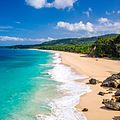María Trinidad Sánchez Province
María Trinidad Sánchez is a province of the Dominican Republic. It is in the northeastern part of the country, along the Atlantic coast. Its capital city is Nagua.
 | |
Coat of arms of Coat of arms | |
 Location of the María Trinidad Sánchez Province | |
| Country | |
| Province since | 1959 |
| Capital | Nagua |
| Government | |
| • Type | Subdivisions |
| • Body | 4 municipalities 5 municipal districts |
| • Congresspersons | 1 Senator 3 Deputies |
| Area | |
| • Total | 1,271.71 km2 (491.01 sq mi) |
| Population (2010) | |
| • Total | 140,925 |
| • Density | 110.8154/km2 (287.0105/sq mi) |
| Time zone | UTC-4 (EST) |
| Area code | 1-809 1-829 1-849 |
| ISO 3166-2 | DO-14 |
| Postal Code | 33000 |
It was created on 1958. It was a municipality of the Samaná province before being elevated to the category of province.
Name
María Trinidad Sánchez was an aunt of Francisco del Rosario Sánchez, one of the founders of the country. She helped the Dominican soldiers during the first days of the independence from Haiti. She was killed on 27 February 1845 by orders of the first Dominican president, Pedro Santana.
History
The territory of the province was part of the Duarte province and then it was made a municipality of the Samaná province. In 1958, it was made a province with the name Julia Molina, after the mother of the dictator Rafael Trujillo, with the municipalities of Julia Molina and Cabrera and the municipal district, later a municipality, of Río San Juan. In 1961, after Trujillo's death, the province was given the present name and the capital was named Nagua.
The municipality of El Factor was created in 1988.
San José de Matanzas was made a municipal district in 1996, Arroyo Salado in 2000, La Entrada and El Pozo in 2001, Las Gordas in 2003 and Arroyo al Medio in 2006.[1]
Location
María Trinidad Sánchez is in the northeast of the country. The province has the Samaná province to the southeast, the Duarte province to the south and west and the Espaillat province to the northwest. The Atlantic Ocean is to the north and east of the province.
Population
In 2010 (last national census), there were 140,925 people living in the María Trinidad Sánchez province, and 74,019 (52.5%) living in towns and cities. The population density was 116.8 persons/km².[2]
Its population represents 1.49% of the total population of the country and the province is ranked as the 20th (out of 31 plus the National District) more populated province.
As of 2016[update], the total estimated propulation of the province is 141,331 inhabitants.[3]
The largest city of the province is Nagua, its capital, with a population (in 2010) of 40,611 inhabitants.[2]
Geography
The María Trinidad Sánchez province has a total area of 1,206.5 km2 (465.8 sq mi).[2] It has 2.5% of the area of the Dominican Republic and it is ranked as the 20th (out of 31 plus the National District) largest province.
The altitude of Nagua, provincial capital, is 4 m (13 ft).[4]
The Cordillera Septentrional (in English, "Northern mountain range") is in the southern part of the province, going from the northwest to the southeast. The mountains here are not very high, and the mountain range ends in the southeastern part of the province, in a large swamp called Gran Estero close to the Samaná province.
Because the mountain range is close to the sea, the rivers are short.
The protected areas in the province are the Natural Scientific Reserve Loma Guaconejo (Reserva Científica Natural Loma Guaconejo), the National Park Cabo Francés Viejo and the National Park Gran Laguna.
Climate
The climate of the province is a tropical climate, hot most of the year.
Municipalities
There are 4 municipalities and 6 municipal districts (M.D.) in the province.[1] The municipalities and its municipal districts (M.D.) are:
| Municipality (code) |
Municipal Districts (code) | Population (2010) |
Area (km2) |
Density | Altitude (m) |
|---|---|---|---|---|---|
| Nagua (140101) | 40,611 | 47.6 | 853.2 | 4 | |
| San José de Matanzas (140102) | 10,586 | 120.9 | 87.6 | 1 | |
| Las Gordas (140103) | 15,359 | 151.6 | 101.3 | 6 | |
| Arroyo al Medio (140104) | 10,437 | 224.8 | 46.4 | 22 | |
| Nagua (140100) | 76,993 | 545.0 | 141.3 | ||
| Cabrera (140201) | 13,371 | 158.4 | 84.4 | 5 | |
| Arroyo Salado (140202) | 7,119 | 62.2 | 114.5 | 13 | |
| La Entrada (140203) | 4,034 | 49.9 | 80.8 | 68 | |
| Cabrera (140200)) | 24,524 | 270.5 | 90.7 | ||
| El Factor (140301) | 13,557 | 96.9 | 139.9 | 12 | |
| El Pozo (140302) | 10,683 | 49.8 | 214.5 | 16 | |
| El Factor (140300)) | 24,240 | 146.7 | 165.2 | ||
| Río San Juan (140401) | 15,168 | 244.3 | 62.1 | 17 | |
| Río San Juan (140400)) | 15,168 | 244.3 | 62.1 | ||
| María Trinidad Sánchez province (140000) | 140,925 | 1,206.5 | 116.8 | ||
Economy
The main economic activities in the province are farming and fishing. In some partes of the province, mainly in the northern parte (Río San Juan and Cabrera), tourism is an important activity because there are many beautiful beaches.
María Trinidad Sánchez Province Media
References
- ↑ 1.0 1.1 "División Territorial 2015" (in Spanish). Oficina Nacional de Estadística (ONE). October 2015. Archived from the original (PDF) on 14 November 2015. Retrieved 7 November 2016.
{{cite web}}: CS1 maint: unrecognized language (link) - ↑ 2.0 2.1 2.2 "IX Censo Nacional de Población y Vivienda 2010" (PDF) (in Spanish). Oficina Nacional de Estadística. June 2012. Retrieved 23 September 2013.
{{cite web}}: CS1 maint: unrecognized language (link) - ↑ "REPÚBLICA DOMINICANA: Población por año calendario, según sexo y grupos quinquenales de edad, 2015-2020" (in Spanish). Oficina Nacional de Estadística (ONE). Archived from the original (XLS) on 24 June 2016. Retrieved 7 November 2016.
{{cite web}}: CS1 maint: unrecognized language (link) - ↑ "Nagua". Geonames.org. Retrieved 7 November 2016.



